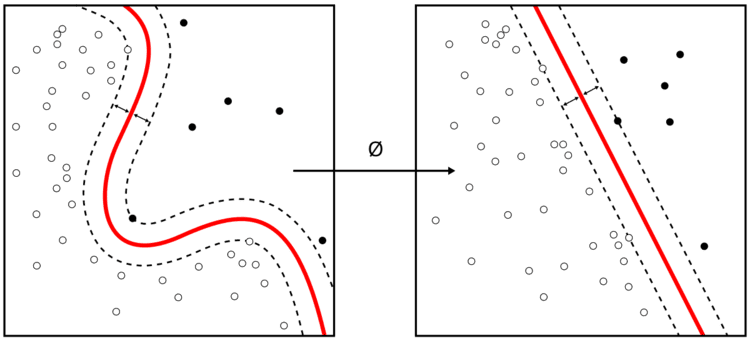 | ||
A multilayer perceptron (MLP) is a feedforward artificial neural network model that maps sets of input data onto a set of appropriate outputs. An MLP consists of multiple layers of nodes in a directed graph, with each layer fully connected to the next one. Except for the input nodes, each node is a neuron (or processing element) with a nonlinear activation function. MLP utilizes a supervised learning technique called backpropagation for training the network. MLP is a modification of the standard linear perceptron and can distinguish data that are not linearly separable.
Contents
Activation function
If a multilayer perceptron has a linear activation function in all neurons, that is, a linear function that maps the weighted inputs to the output of each neuron, then it is easily proven with linear algebra that any number of layers can be reduced to the standard two-layer input-output model (see perceptron). What makes a multilayer perceptron different is that some neurons use a nonlinear activation function which was developed to model the frequency of action potentials, or firing, of biological neurons in the brain. This function is modeled in several ways.
The two main activation functions used in current applications are both sigmoids, and are described by
in which the former function is a hyperbolic tangent which ranges from -1 to 1, and the latter, the logistic function, is similar in shape but ranges from 0 to 1. Here
Layers
The multilayer perceptron consists of three or more layers (an input and an output layer with one or more hidden layers) of nonlinearly-activating nodes and is thus considered a deep neural network. Since an MLP is a Fully Connected Network, each node in one layer connects with a certain weight
Learning through backpropagation
Learning occurs in the perceptron by changing connection weights after each piece of data is processed, based on the amount of error in the output compared to the expected result. This is an example of supervised learning, and is carried out through backpropagation, a generalization of the least mean squares algorithm in the linear perceptron.
We represent the error in output node
Using gradient descent, we find our change in each weight to be
where
The derivative to be calculated depends on the induced local field
where
This depends on the change in weights of the
Terminology
The term "multilayer perceptron" often causes confusion. It is argued the model is not a single perceptron that has multiple layers. Rather, it contains many perceptrons that are organised into layers, leading some to believe that a more fitting term might therefore be "multilayer perceptron network". Moreover, these "perceptrons" are not really perceptrons in the strictest possible sense, as true perceptrons are a special case of artificial neurons that use a threshold activation function such as the Heaviside step function, whereas the artificial neurons in a multilayer perceptron are free to take on any arbitrary activation function. Consequently, whereas a true perceptron performs binary classification, a neuron in a multilayer perceptron is free to either perform classification or regression, depending upon its activation function.
The two arguments raised above can be reconciled with the name "multilayer perceptron" if "perceptron" is simply interpreted to mean a binary classifier, independent of the specific mechanistic implementation of a classical perceptron. In this case, the entire network can indeed be considered to be a binary classifier with multiple layers. Furthermore, the term "multilayer perceptron" now does not specify the nature of the layers; the layers are free to be composed of general artificial neurons, and not perceptrons specifically. This interpretation of the term "multilayer perceptron" avoids the loosening of the definition of "perceptron" to mean an artificial neuron in general.
Applications
Multilayer perceptrons using a backpropagation algorithm are the standard algorithm for any supervised learning pattern recognition process and the subject of ongoing research in computational neuroscience and parallel distributed processing. They are useful in research in terms of their ability to solve problems stochastically, which often allows one to get approximate solutions for extremely complex problems like fitness approximation.
MLPs are universal function approximators as showed by Cybenko's theorem, so they can be used to create mathematical models by regression analysis. As classification is a particular case of regression when the response variable is categorical, MLPs are also good classifier algorithms.
MLPs were a popular machine learning solution in the 1980s, finding applications in diverse fields such as speech recognition, image recognition, and machine translation software, but have since the 1990s faced strong competition from the much simpler (and related) support vector machines. More recently, there has been some renewed interest in backpropagation networks due to the successes of deep learning.
